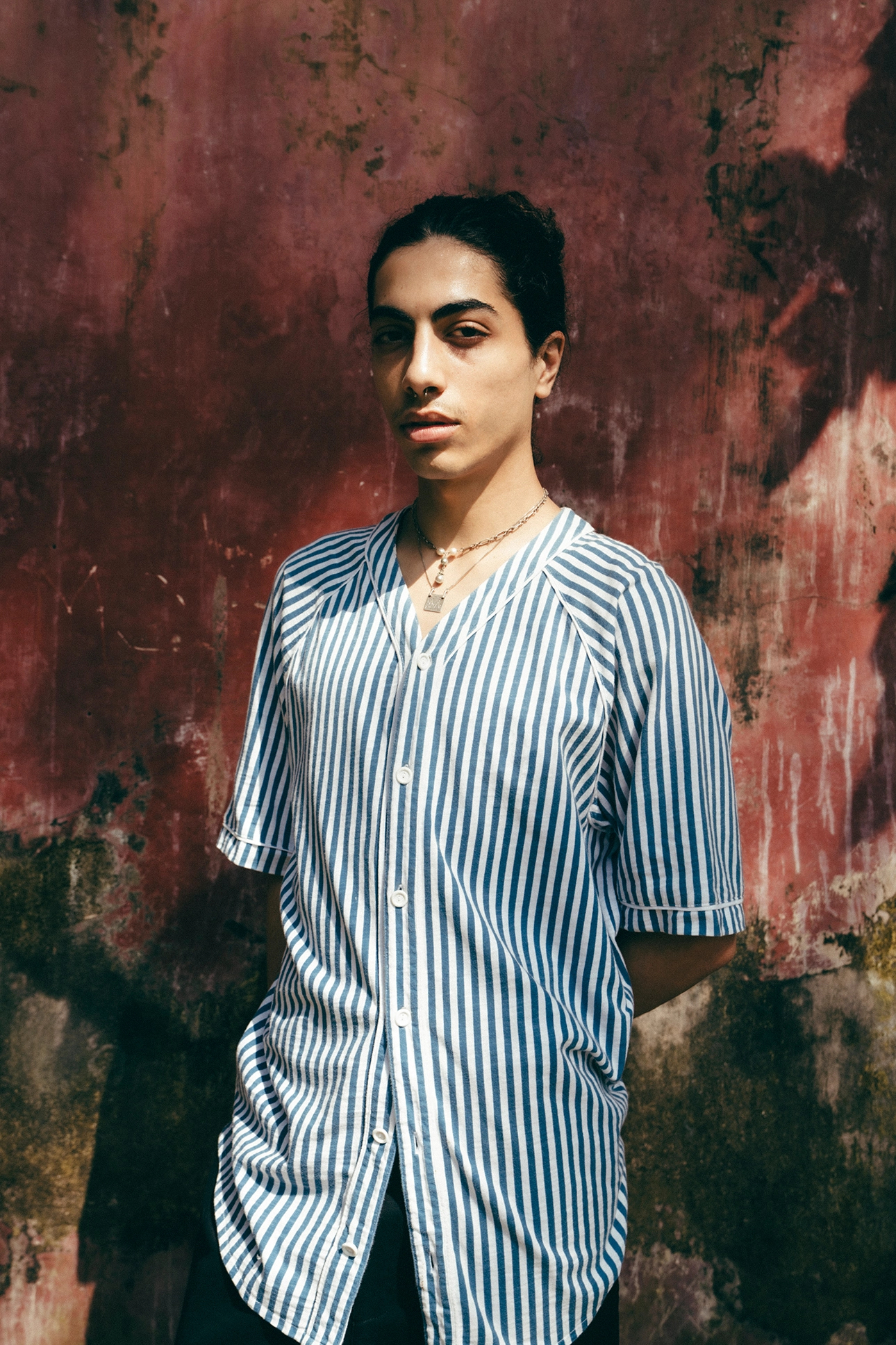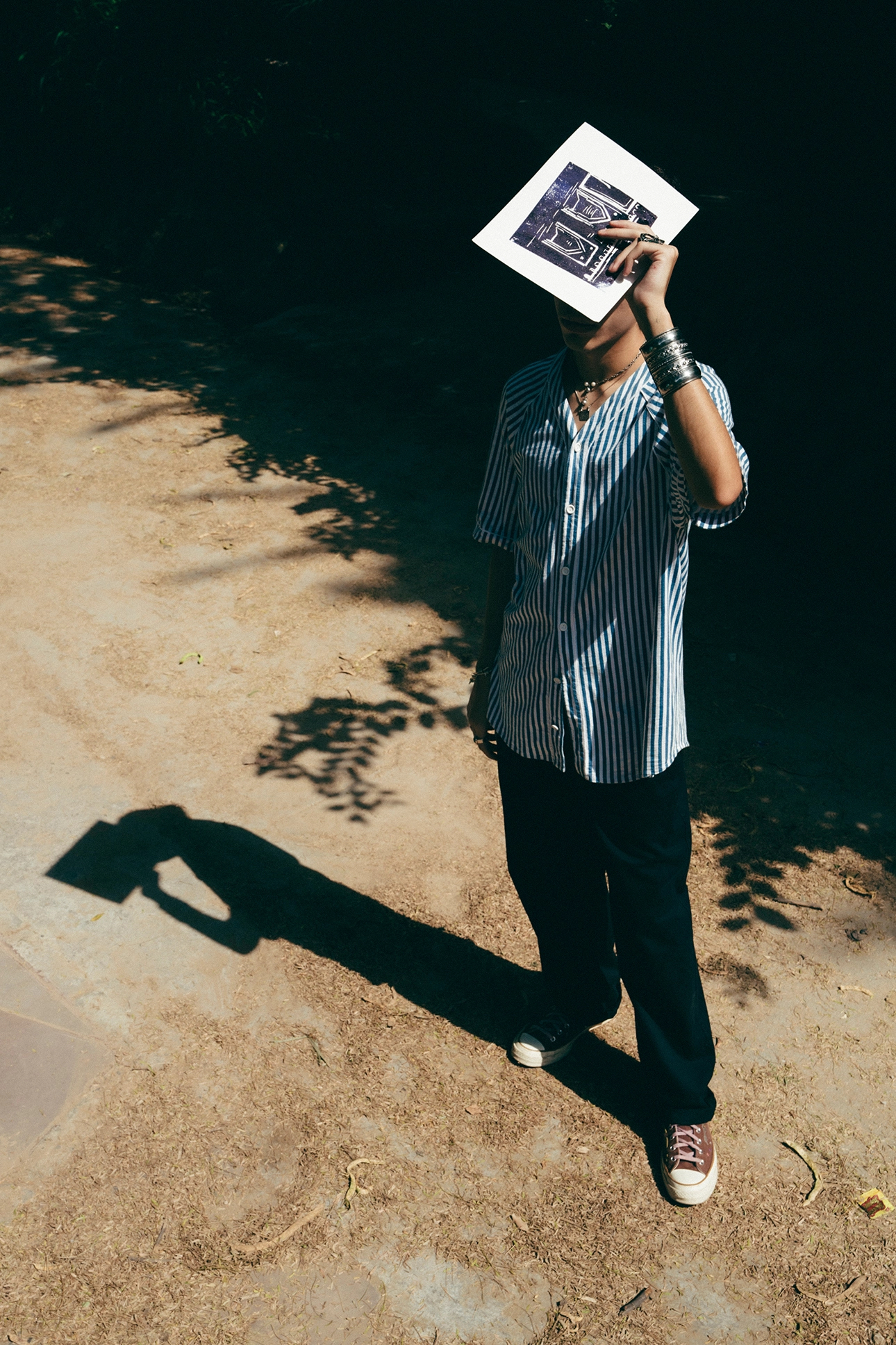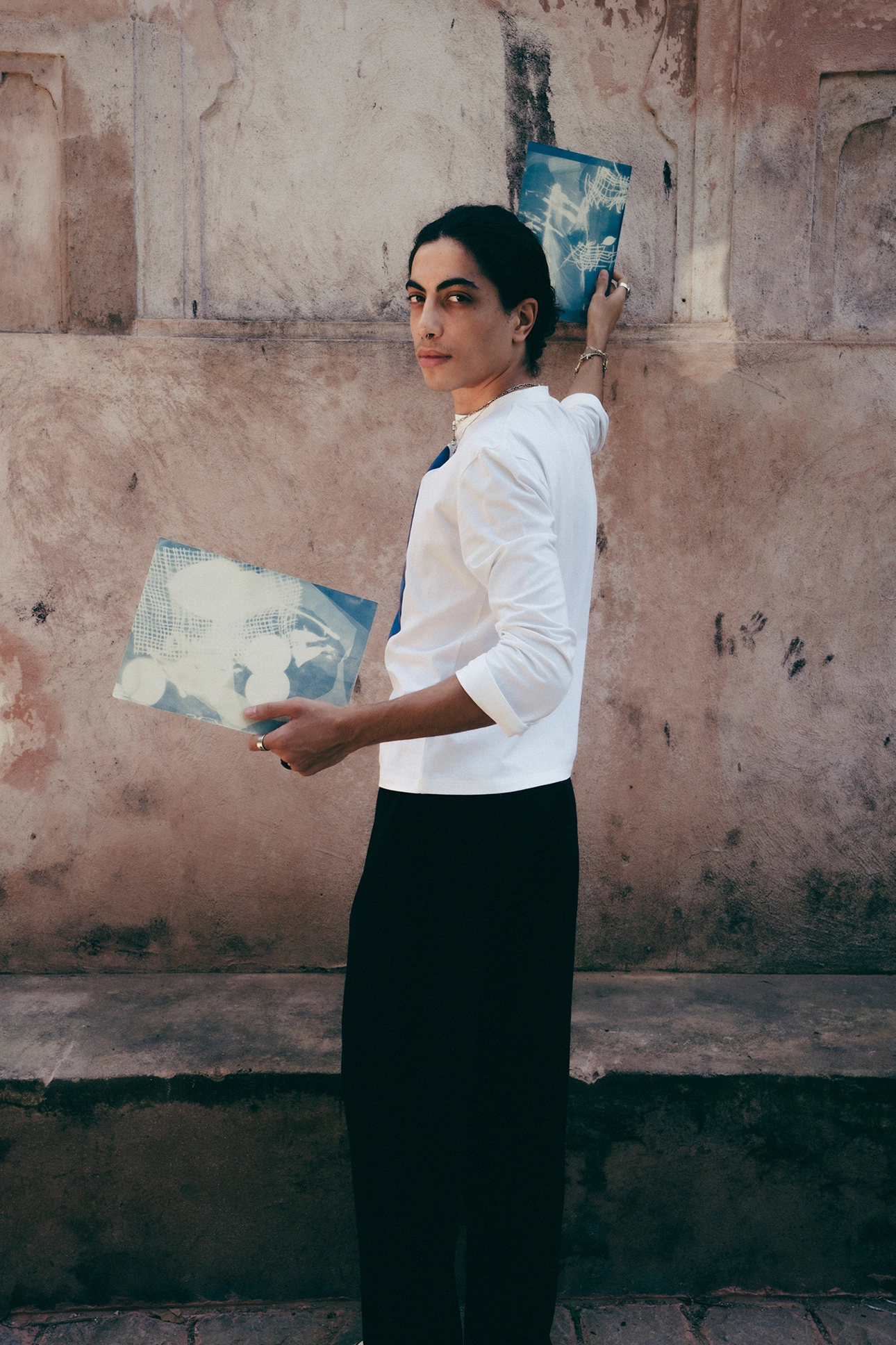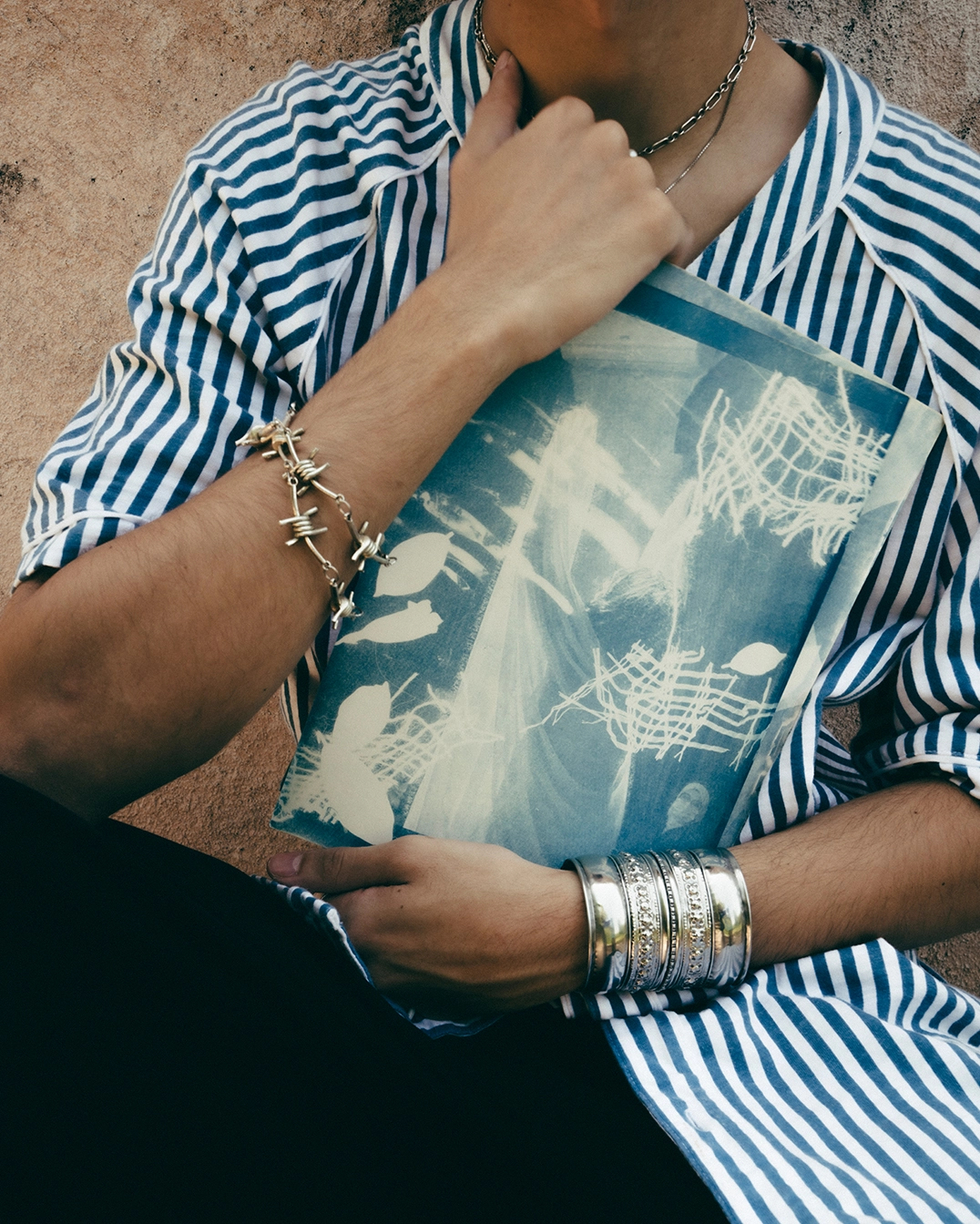Double Roles: Faris Ansari
Though modelling as a career has its doses of glitzy glamour, it is fast, demanding and fleeting. Verve speaks to four models who have sensitively expanded their repertoire and enriched their lives by simultaneously pursuing their passion for fashion and the arts
Faris Ansari, Delhi
Mixed Media

Models are — and have always been — the visible face of the fashion and beauty industries. Injecting a certain je ne sais quoi into the brand identity with an ease that almost masks the pains taken to execute the vision of the creative heads, they are one of the primary draws that attract the attention of the viewers — and, by extension, the buyers. But it is well known that despite their integral function to these industries, their “shelf life” is limited.
The digital content business, driven by algorithms, is under constant pressure to produce fresh imagery, leading the fashion industry to churn out content at a hectic, unsustainable pace. The number of fashion collections presented annually has increased from two to four to, in some cases, double digits. Designers, who choose to abide by the same visual codes for more than three seasons — that is, about a year — are declared one-trick ponies by audiences online. The need to be distinctive on platforms frequented by billions drives the image makers of the fashion industry to always be on the hunt for new and, often, younger talent. Perhaps the most vulnerable casualties of this cycle are models. Many — designers, stylists, make-up artists, photographers — often have the leeway to switch up aesthetics but it’s often a matter of time before models lose their visual currency. Additionally, and ironically, being a recognisable face may also translate into losing out on the order of the day — the freshness factor — and jobs.
Interestingly, many are simultaneously following their creative interests in the arts to express their inner muse and thus wearing multiple hats. We take a deep dive into the artistic pursuits of four models in an effort to stand out in the clutter.
Excerpts from the conversation….
How did you get into modelling?
I knew that modelling was something that I would pursue, ever since my mind opened up to the idea of doing it. However, coming from Palestine, I was aware that opportunities in the field would be limited there. Recognising this, I chose to focus on the other half of my identity (I am half Indian and half Palestinian) and actively reached out to an Indian agency, to start my modelling journey in India while pursuing my studies.
Modelling has always been more than just a career path for me — it’s an opportunity to showcase cultural integration. My work represents the merging of two vastly different worlds and highlights how diverse identities can coexist and thrive. It allows me to be a voice and a visual representation for a small yet significant group of people, bridging cultural narratives through fashion and art.
Modelling as a career has undergone so many transformations over the past two decades. Do you find yourself tasked with additional responsibilities and expectations to build or sustain your modelling profile?
Modelling has definitely evolved over the years. It’s no longer just about posing in front of a camera — models today are expected to be much more involved in shaping their brand. In my case, I believe that being a model today means blending the art of storytelling with my personal identity and cultural experiences.
The expectations for building and sustaining my modelling profile also extend to maintaining a presence on social media, engaging with creatives in the industry and finding inspiration from them, while showcasing my versatility. It’s not just about looking good on camera — it's about showing your personality, building relationships, and finding ways to stay relevant in an ever-changing industry. I embrace these challenges, as they provide me with a platform to represent my culture and work with a wide range of creative professionals.
As a model who hails from Palestine, I am acutely aware of how rare and significant this role is. There are few Palestinian models and the pressure to set a milestone and build an image that resonates with my nation can be overwhelming at times. This responsibility weighs on me, but it also fuels my drive and pride. It gives me a deep sense of purpose and confidence in my work, knowing that I can contribute to breaking boundaries and create visibility for underrepresented cultures in the creative world.
What role does social media play in your career?
Social media has undeniably played a significant role in the development of my career, especially in terms of visibility and connectivity. On the one hand, it’s a platform that allows me to showcase my work, share my personal experiences and inject my cultural narrative into the fashion industry. Through styling, storytelling and the creative direction I bring to the shoots I’m asked to collaborate on, social media has served as an invaluable tool to showcase my creative point of view. It’s given me the opportunity to connect with like-minded creatives and collaborators globally, opening doors that might not have been accessible otherwise.
However, there’s a flip side. Social media operates in a fast-paced, ever-changing environment, where trends come and go in the blink of an eye. While this can be exciting, it often undermines the immense effort and artistry that go into creating meaningful and impactful work. I find that creative professionals sometimes don’t get the recognition they deserve because social media tends to prioritise fleeting attention rather than the depth of work that takes place behind the scenes. This constant cycle can make it challenging to truly highlight the dedication and craftsmanship that goes into producing high-quality, artistic content.
What are the factors that you bear in mind while positioning yourself and your work digitally?
I don’t put too much effort into actively publishing my work, especially when it comes to my visual art and paintings. When I was living in Palestine, I found that my art had a more organic life — it was exhibited in physical spaces and studios where people could experience it directly. I never focused on digitalising my art or sharing it online as I preferred the authenticity of people experiencing it in person. In that environment, my work spoke for itself without needing constant promotion.
However, when it comes to my modelling career, the digital space plays a more prominent role. As I collaborate with different brands, magazines and creatives, the process of sharing and positioning the images in the digital world becomes a natural part of the process. I take the initiative to share these images on my platforms but I also appreciate how the brands and creatives I work with ensure that the visuals reach a wider audience digitally.
It’s a bit of a balancing act. While I enjoy the visibility that digital platforms provide, especially in fashion and modelling, I also value the authenticity of physical spaces and the personal connections that come from sharing my art in real life. But I recognise that in today’s world, the digital realm is where much of the exposure and community building happens, and it’s something that I’ve learned to embrace as a necessary aspect of our interconnected world.

What’s a modelling project that you loved working on?
One of my favourite projects was in Mumbai for an alcohol brand. It was a three-day shoot in multiple locations, and what made it my favourite was the level of freedom and creativity it allowed.
The first moments were shot around the iconic Grand Hotel in Mumbai. The streets were shut off for us, and the road was transformed to reflect an early 20th-century vibe, with vintage cars brought in to set the scene. I was put in a Studio 54-inspired, blinged-out red bodysuit, and the best part was that I wasn’t given a character to play. I was simply asked to be myself — dancing, running, posing all over the road. It felt completely organic like the space was mine to claim, and I gave it my all.
This project stood out for its freedom and the large-scale production involved. The other scenes were shot in a metro station. I had the opportunity to connect with many models from all over India and the world, which made the experience even more special. It was definitely the most time-intensive project I’ve worked on. It showed me just how much I can achieve when I push myself creatively.
How do the two careers feed into and augment each other?
They definitely inspire each other. My art is deeply rooted in my life experiences, and I see it as a way to shine a light on things we often overlook or take for granted. Being on set, surrounded by creatives, clothing, and jewellery, fuels my imagination and encourages me to bring elements from that world into my art.
Tell us about your experience of working with museums and art galleries.
My journey began in the Old City of Jerusalem. The layers of history, intertwined cultures, religions, and ideologies ignited my creative spirit. I worked in a workshop and gallery located in the heart of the Old City, surrounded by working artists. There, I helped organise exhibitions in a space framed by the rustic arches and weathered, sand-textured walls. The atmosphere of that place — both its visual and historical richness — elevated our art, making it feel timeless and deeply connected to its environment.
I carried this appreciation for history and culture to my time at the Hospital de los Venerables in Seville, Spain. Working in this museum, surrounded by masterpieces like those of Diego Velázquez, was transformative. My role included managing events, curating social media content, and writing about the museum’s history and its collection. The archives, with books that are over a thousand years old, became a treasure trove of inspiration. This experience also challenged me creatively, especially during the last two months when I was entrusted with greater responsibilities while the director was on maternity leave. The pressure of working independently pushed me to my limits, producing work I’m incredibly proud of.
Lastly, my exposure in Delhi introduced me to the modernity of contemporary gallery spaces. These minimalistic architectural designs create a sharp contrast to the historical settings I’d been accustomed to. The clean lines and focus on the artwork itself taught me how modern spaces can highlight art in a completely different way.
Each of these experiences has left an indelible mark on my creative practice, providing me with unique perspectives and endless inspiration.
Did working on the logistical and communications aspect of art influence your approach to art?
Through these experiences, I’ve learned valuable skills like managing locations, curating how art is displayed, and creating content in the most effective way possible. It also gave me insight into the social and sociological dimensions of the industry — how art impacts viewers and how their minds engage with it. This understanding has influenced how I think about my work’s purpose and its connection with audiences.
That said, while these skills have helped me understand the logistics of presenting art, I haven’t fully applied them to my artistic work just yet. I don’t believe it’s the right time for that. Currently, my focus is more on the industry, where I’m building my career. My personal art, on the other hand, remains something very intimate — something I’m carefully developing within the circle of people I want to surround myself with.
Logistics, especially, are crucial to the behind-the-scenes management. The spaces I worked with often had specific goals: to publish their work, ensure it was seen and that it resonated with the right audiences. I made their goals my own and worked diligently to help them achieve those aims. This has instilled in me a mindset of intention and purpose when creating or presenting art, even if I’m keeping my own work personal for now.

Could you describe the cyanotypes in the images and what they represent?
The cyanotypes hold a very personal significance as they were my first experiments with this medium. I had always been fascinated by cyanotypes but couldn’t access the necessary materials and chemicals while living in Jerusalem. It wasn’t until my time at university, where I had access to an art studio, that I finally had the chance to teach myself this process.
When I started creating cyanotypes, the first thing that came to mind was incorporating elements from my home in Jerusalem. The technique itself was something I learned about back home, so it felt only natural to bring a piece of it into my work. For the cyanotypes, I used a leaf I had kept in my phone case as a memory from home and a piece of a rice sack commonly used in Jerusalem that I had with me in my room.
At the same time, I wanted the work to be a collaboration between two regions — home and identity. So, I incorporated materials I found locally around the studio space in India, grounding the piece in its immediate environment while connecting it to my roots.
The cyanotypes, in essence, represent a merging of two worlds. They are a dialogue between where I come from and my identity, using the medium as a bridge to bring both into conversation. This layering of materials and regions is a way for me to explore and honour both spaces simultaneously.
What role does your upbringing in Jerusalem play in your art?
Visiting Jerusalem alone is an experience that leaves an everlasting impression on anyone. Many of my friends who have visited have expressed deep appreciation and awe for the way of life there, shaped by its history of conflict and coexistence. Despite the tensions, people manage to wake up each day and interact with one another, creating a unique rhythm of life that’s both resilient and inspiring.
Each city in Palestine — Jerusalem, Ramallah — and even Tel Aviv has its own distinct artistic flavour that has deeply influenced me. Living in Jerusalem, I was constantly struck by the historical architecture and how it coexists with the lives of modern tenants. My family lives in one of these unique homes where the tension between the old and the new is always present. Renovation often comes with the challenge of balancing tradition with contemporary tools but, for me, it has always been a source of inspiration.
The daily life of the Palestinian people is another key influence. From the farmers tending to the land, to the bustling city life, to the vibrant nightlife, the culture is rich and layered. The villages, with their raw architectural beauty, showcase the resourcefulness of the people — the use of local stones for houses, the way these structures seem to organically extend from the historical green landscape.

Tell us about your other artistic influences?
Two artists have deeply influenced my art, each in their unique way. The first is my mentor and teacher, Ahed Izhiman. Ahed was instrumental in shaping the beginning of my artistic journey. He was the first to teach me about the interplay of shapes and shadows and showed me how to channel surrounding negativity into positivity, transforming it into meaningful work. His belief in me and the safe space he provided allowed me to grow as an artist. I deeply admire him not just as a teacher and mentor but as a true pioneer. Ahed has faced many challenges but has emerged as a successful entrepreneur, artist and advocate for the arts, launching numerous exhibitions, studios and galleries. His story of perseverance continues to inspire me every day.
The second is my friend, Yusor Hamed. Yusor’s music has been a constant source of inspiration. She is a groundbreaking Palestinian singer, songwriter and producer who blends Middle Eastern cadences with European electronica, weaving traditional Arabic instruments with modern sounds. Her work defies expectations and challenges societal norms, creating a new Palestinian sound that’s truly her own. Since I first met Yusor, her music has been a companion to my creative process. Whether I was at home in Jerusalem, working in Spain, or exploring India, her songs have always opened up space in my mind for inspiration.
When I listen to her music and close my eyes, I can vividly imagine entire scenes unfolding — different ones every time I revisit the same song. Listening to her feels like meditation — it quiets the noise and nurtures my creative energy, allowing me to create with clarity and purpose.
Together, Ahed and Yusor have taught me the value of resilience, innovation and staying true to one’s voice, no matter the circumstances.
Which career takes precedence over the other?
In my life, I see these two paths as a dance, a balance. There are times when one takes precedence — for example, when I focus on professional projects, engaging with the industry to grow, connect and make an impact. And then there are moments when I step back, needing to release my creative energy through my art. Sometimes, my ideas demand a paintbrush or the feel of clay and at other times, they call for a camera and the perfect styling of clothes.
When it comes to measuring their impact, I see them leaving different kinds of marks. My personal art carries the weight of home — it’s lasting, rooted in history and culture, and resonates with those who understand or are seeking that connection. For my community back home, I hope it becomes a source of pride, a representation of our collective spirit and resilience.
Internationally, my professional work often takes center stage. It resonates with a broader audience, particularly those who relate to or are inspired by the blend of identities and stories I bring into my projects. It offers a sense of representation that many people might be longing for — a mix of cultures, experiences and creativity that feels both personal and universal.
Ultimately, I don’t see one as more significant than the other. They are two sides of the same coin, constantly exchanging places to create harmony in my life. Each feeds into the other, ensuring that neither my personal vision nor my professional contributions are left behind.
Previous: Amrit Singh Sindhu
Next: Yaikhom Sushiel (Dame Imfala)